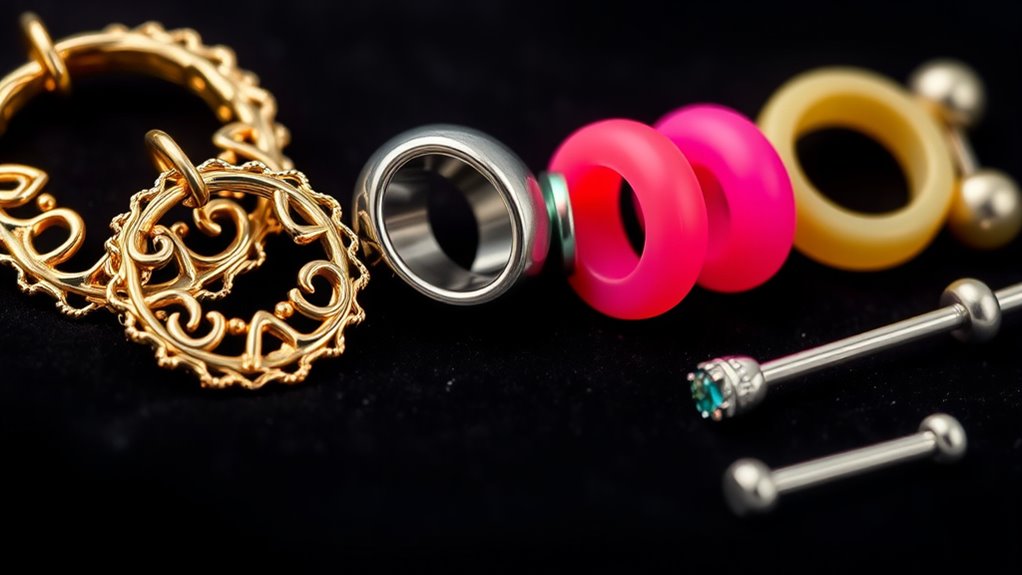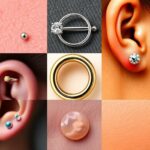When choosing piercing jewelry, you’ll find options like surgical stainless steel, titanium, niobium, and high-karat gold, all designed for safety, durability, and hypoallergenic wear. Surgical stainless steel and titanium are popular for their strength and resistance to corrosion, making them ideal for healing. Gold, especially higher karats, can also be safe but needs careful selection to avoid allergens. To confirm your jewelry supports healthy healing, explore the material details further.
Key Takeaways
- Common materials include surgical stainless steel, titanium, niobium, gold, and sometimes platinum or bioplastics.
- Surgical stainless steel and titanium are highly durable, hypoallergenic, and resistant to corrosion.
- Gold jewelry, especially 14k or higher, is generally safe but may contain alloys that cause allergies.
- Niobium is a hypoallergenic, lightweight, and corrosion-resistant metal suitable for sensitive skin.
- Bioplastics and PTFE are flexible, biocompatible options often used for initial piercings or sensitive skin.

Are you curious about what materials are best for piercing jewelry? Choosing the right material is vital not just for aesthetic reasons but also for your health and comfort. When considering jewelry, you need to think about allergy considerations and material durability. These factors help guarantee your piercing heals properly and stays looking great over time.
Choosing the right piercing jewelry ensures health, comfort, and long-lasting beauty.
Starting with allergy considerations, some materials are more likely to cause allergic reactions than others. Nickel, for example, is a common allergen found in many jewelry pieces, especially cheaper or poorly coated ones. If you have sensitive skin or a history of allergies, you’ll want to steer clear of jewelry that contains nickel or other irritants. Instead, opt for hypoallergenic options like surgical stainless steel, titanium, or niobium. These materials are less likely to trigger reactions because they are biocompatible and have minimal allergenic properties. Gold jewelry, especially 14k or higher, can also be safe for most people, but be cautious with lower karat gold or gold-plated pieces, which might have nickel or other alloys underneath. Knowing about allergy considerations helps you choose jewelry that won’t cause discomfort or infections during the healing process.
Material durability is another key factor. Piercing jewelry needs to withstand daily wear, exposure to water, sweat, and sometimes harsh cleansers. If the material isn’t durable, it can tarnish, degrade, or even break, which could cause injuries or infections. Surgical stainless steel is known for its strength and resistance to corrosion, making it a popular choice among piercers and wearers alike. Titanium is even more durable, lightweight, and highly resistant to scratches and corrosion, making it ideal for active lifestyles. Niobium shares similar qualities, but it’s less commonly used and may be harder to find. Gold, especially higher purity options, tends to be softer and more prone to scratching or bending, so it might not be the best for jewelry that needs to endure rough handling or frequent cleaning. When selecting jewelry, you want a material that maintains its integrity over time, preventing complications or the need for replacements. Additionally, understanding regulations and standards can help ensure you’re purchasing safe and quality jewelry.
Ultimately, understanding allergy considerations and material durability helps you make informed choices about your piercing jewelry. It guarantees your piercing heals smoothly and remains comfortable and attractive long-term. Don’t rush your decision—investing in high-quality, hypoallergenic, and durable jewelry is worth it for the health and appearance of your piercing. After all, the right materials not only look good but also protect your skin and keep your piercing in top condition.
Frequently Asked Questions
What Are the Best Hypoallergenic Materials for Sensitive Skin?
If you have sensitive skin, you should choose hypoallergenic metals like surgical stainless steel, titanium, niobium, or platinum. These materials are known for being gentle and reducing allergic reactions, making them ideal sensitive skin solutions. You’ll find that hypoallergenic jewelry minimizes irritation and keeps your piercing comfortable. Always opt for high-quality, medical-grade metals to guarantee your skin stays healthy and free from discomfort.
How Do Metal Prices Affect Jewelry Material Choices?
A penny saved is a penny earned, especially when metal prices fluctuate. You’ll notice that metal price fluctuations directly impact your jewelry material choices, as higher costs may lead to choosing more affordable options or delaying purchases. Material scarcity impact also plays a role, making rare metals less accessible and influencing your options. Staying adaptable helps you enjoy stylish jewelry without breaking the bank during market swings.
Can Certain Materials Cause Allergic Reactions Over Time?
Yes, certain materials can cause allergic reactions over time. If you have nickel sensitivity, wearing jewelry with nickel can lead to irritation or allergic responses. To prevent this, opt for surgical grade titanium, which is hypoallergenic and less likely to cause reactions. Always check the material composition of your jewelry, especially if you notice itching, redness, or swelling, to protect your skin and ensure safe healing.
Are There Eco-Friendly or Sustainable Piercing Jewelry Options?
Yes, you can find eco-friendly or sustainable piercing jewelry options. Look for pieces made from recycled metals, which reduce environmental impact, or choose plant-based materials like bamboo or bioplastics. These options are not only gentle on your skin but also support sustainability efforts. By selecting jewelry crafted from recycled metals or plant-based materials, you contribute to reducing waste and protecting the planet while enjoying stylish, eco-conscious accessories.
How Do Material Choices Influence Jewelry Longevity and Durability?
While shiny, delicate jewelry might seem appealing, your choice of material greatly impacts its durability. You’ll find that high-quality metals resist material corrosion, ensuring your piercing stays intact longer. Manufacturing techniques also play a vital role; precision crafting enhances strength and longevity. So, opting for durable materials combined with expert craftsmanship means your jewelry will endure daily wear, maintaining its appearance and safety for years to come.
Conclusion
Choosing the right material for your piercing jewelry is like planting a sturdy tree; it guarantees your piercing stays healthy and strong. By understanding the different options, you can avoid unwanted reactions and enjoy your new look confidently. Remember, your body is your canvas—selecting quality materials is the brush that keeps your art vibrant and lasting. So, take the time to choose wisely, and let your jewelry be a reflection of care and craftsmanship.
Piecing together a life one day at a time, that’s me. I’m Rusty, and I love being editor-in-chief of creative piercing. It’s my passion to help others see their vision and bring it to life. When I’m not working or taking care of my family, you can find me reading a good book or eating pie (of course!).

















